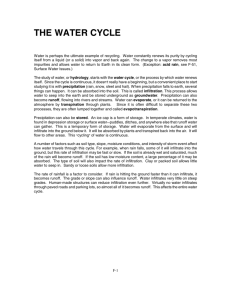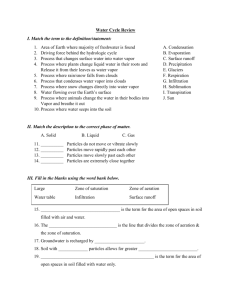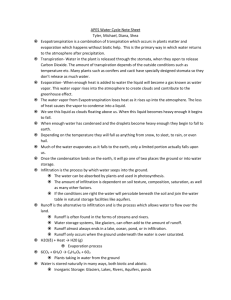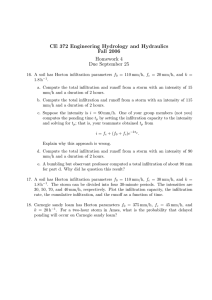36688. E-mail: .
advertisement
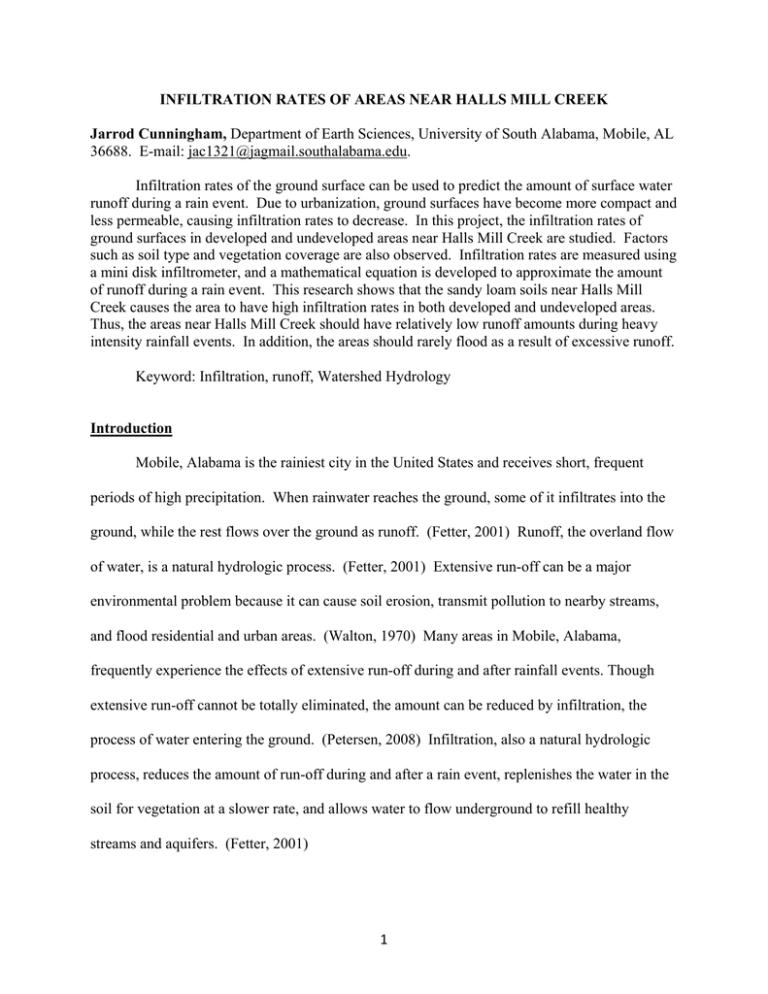
INFILTRATION RATES OF AREAS NEAR HALLS MILL CREEK Jarrod Cunningham, Department of Earth Sciences, University of South Alabama, Mobile, AL 36688. E-mail: jac1321@jagmail.southalabama.edu. Infiltration rates of the ground surface can be used to predict the amount of surface water runoff during a rain event. Due to urbanization, ground surfaces have become more compact and less permeable, causing infiltration rates to decrease. In this project, the infiltration rates of ground surfaces in developed and undeveloped areas near Halls Mill Creek are studied. Factors such as soil type and vegetation coverage are also observed. Infiltration rates are measured using a mini disk infiltrometer, and a mathematical equation is developed to approximate the amount of runoff during a rain event. This research shows that the sandy loam soils near Halls Mill Creek causes the area to have high infiltration rates in both developed and undeveloped areas. Thus, the areas near Halls Mill Creek should have relatively low runoff amounts during heavy intensity rainfall events. In addition, the areas should rarely flood as a result of excessive runoff. Keyword: Infiltration, runoff, Watershed Hydrology Introduction Mobile, Alabama is the rainiest city in the United States and receives short, frequent periods of high precipitation. When rainwater reaches the ground, some of it infiltrates into the ground, while the rest flows over the ground as runoff. (Fetter, 2001) Runoff, the overland flow of water, is a natural hydrologic process. (Fetter, 2001) Extensive run-off can be a major environmental problem because it can cause soil erosion, transmit pollution to nearby streams, and flood residential and urban areas. (Walton, 1970) Many areas in Mobile, Alabama, frequently experience the effects of extensive run-off during and after rainfall events. Though extensive run-off cannot be totally eliminated, the amount can be reduced by infiltration, the process of water entering the ground. (Petersen, 2008) Infiltration, also a natural hydrologic process, reduces the amount of run-off during and after a rain event, replenishes the water in the soil for vegetation at a slower rate, and allows water to flow underground to refill healthy streams and aquifers. (Fetter, 2001) 1 William Horton, an American soil scientist and ecologist, developed the theory of infiltration and runoff. (Fetter, 2001) Scientists such as Henry Darcy, Green, and Ampt later expanded the theory mathematically by studying infiltration as it relates to time and soil type, also known as the infiltration rate. (Fetter, 2001) The infiltration rate, the rate at which water enters the ground, depends on factors such as the type of soil in the area as well as the saturation level of the ground. (Perrolf, 1995) Measurements of infiltration rates have been measured and studied by scientists throughout the world to help measure and predict hydrologic events. Measurements of the infiltration rate are needed in Mobile, Alabama, to help predict the amount of run off in an area, thereby predicting flood prone areas and areas that may experience high soil erosion. In this project, the infiltration rates of a residential, forested, and business area near Hall Mill Creek are investigated to compare and contrast the effect ground surfaces and vegetation have on infiltration. In addition, the runoff amounts in the research areas during and after a rain event can be calculated. Research Question How does the Infiltration rate of the forested, residential, and business areas near Halls Mill Creek affect runoff. Study Area The Dog River Watershed, the area of land where all of the water that is under it drains into the Dog River, is located in Mobile County, Alabama and includes a section of the city of Mobile, Alabama. (Fearn, 2014) Halls Mill Creek is a tributary of Dog River, and is thusly located in the Dog River Watershed. The infiltration rates of a forested, residential, and business area near Halls Mill Creek were researched. (Figure 1) The forested area, located where Demetropolis Road intersects Halls Mill Creek, consists of both trees and grasses, and is vastly 2 and densely vegetated. The residential area is located at the intersection of Halls Mill Road and Demetropolis Road, and consists of an apartment complex adjacent to an open field. Lastly, the business area is located close to the roads, businesses, and parking lots where Government Street intersects Halls Mill Creek. Methods Figure 1: Map of research areas near Halls Mill Creek A mini disk infiltrometer, a device that measures infiltration rates, was used to collect measurements of the infiltration rates of the ground in our research areas. (Figure 2) For each observation, the infiltrometrer was filled with water to a given height and the suction head was set to 2 cm. When the water-filled infiltrometer is placed on soil, the soil creates a natural suction action that absorbs the water from the infiltrometer over time. (Weight, 2008) The amount of water loss from the infiltrometer was recorded every 30 seconds using a stopwatch. The type of soil directly under the infiltrometer was also recorded. Four measurements were taken in each of the three research areas over a two-week period. Decagon Devices, the maker of the mini disk Figure 2: Picture of an Infiltrometer infiltrometer, created a basic Microsoft Excel spreadsheet to help calculate hydrologic values 3 from measured data by the infiltrometer. Both the infiltration rates and soil type for each measurement were entered into the Decagon Spreadsheet in Excel to determine the area’s saturated hydraulic conductivity, a numeric value that describes the ease with which water can move through pore spaces or fractures in soil. (Fetter, 2001) Since the infiltration rate at equilibrium (or minimum infiltration rate) is equal to the saturated hydraulic conductivity, an approximate equation for runoff based on Horton’s hydraulic equation can be written as ܴ ൌ ܵ െ ܫ , where R = Runoff rate (inches/hour), S = Rainfall intensity (inches/hour), and Ie = Infiltration rate at equilibrium (inches/hour). (Mayes, 2004) The infiltration at equilibrium rate for all soil types range from 0.072 inches/hour for clay soils to 6 inches/hour for sandy soils. (Weight, 2008) Rainfall intensity is classified according to the rate of precipitation. Light rain is categorized as having a precipitation rate less than 0.098 inches/hour. (Mayes, 2004) Moderate rain is categorized as having a precipitation rate between 0.098 inches/hour and 0.30 inches/hour. (Mayes, 2004) Heavy rain is categorized as having a precipitation rate between 0.30 inches/hour and 2.0 inches/hour. (Mayes, 2004) Finally, a violent rain is categorized as having a precipitation rate of more than 2.0 inches/hour. (Mayes, 2004) Results The Infiltration rate at equilibrium was 0.80 inches/hour in the forested area, 1.28 inches/hour in the residential area, and 2.51 inches/hour in the business area. The soil for all three areas was sandy loam. Sandy loam is a very porous material and allows water to infiltrate very quickly and easily. (Weight, 2008) The forested area had lower infiltration rates due to the high amounts of ground moisture contained in the soil by vegetation. In addition, trees block the 4 sun in the forested area from amply evaporating the ground moisture. Both the residential and business areas had dry sandy loam soil, allowing water to infiltrate at a higher rate. Conclusion Due to the relatively high infiltration rates, the areas near Halls Mill Creek should have relatively low runoff amounts during heavy intensity rainfall events. For runoff to occur in the research areas, the rainfall intensity must be classified as at least heavy. Though Mobile has been known to get heavy and violent rainfall intensity events, the short time span (usually less than one hour) of the storm allows little runoff to develop. In addition, the research areas should rarely flood as a result of excessive runoff. For future research, it would be interesting to look at other creeks farther upstream in the Dog River Watershed, and to compare and contrast its infiltration rate at equilibrium and runoff amounts to that of Halls Mill Creek. References Cited Fearn, M. (n.d.). Dog River Watershed. Dog River Watershed. Retrieved March 14, 2014, from http://dogriver.southalabama.edu/ Fetter, C. W. (2001). Applied hydrogeology (4th ed.). Upper Saddle River, N.J.: Prentice Hall. Mays, Larry W. (2004). Urban stormwater management tools. New York : McGraw-Hill. Perrolf, K., & Sandstrom, K. (1995). Correlating Landscape Characteristics and Infiltration. A Study of Surface Sealing and Subsoil Conditions in Semi-Arid Botswana and Tanzania. Geografiska Annaler. Series A, Physical Geography, 77(3), 119. Petersen, S. L., & Stringham, T. K. (2008). Infiltration, Runoff, and Sediment Yield in Response to Western Juniper Encroachment in Southeast Oregon. Rangeland Ecology & Management, 61(1), 74-81. Walton, W. C. (1970). Groundwater resource evaluation. New York: McGraw-Hill. Weight, W. D. (2008). Hydrogeology field manual (2nd ed.). New York: McGraw-Hill. 5
